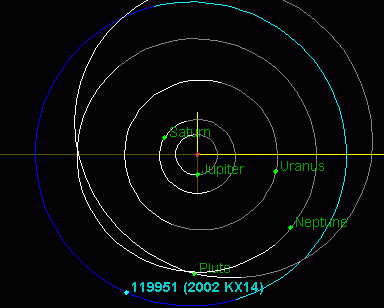(119951) 2002 KX14
| Discovery | |
|---|---|
| Discovered by | Michael E. Brown, Chad Trujillo |
| Discovery date | 17 May 2002 |
| Designations | |
| MPC designation | (119951) 2002 KX14 |
|
TNO cubewano plutino-like |
|
| Orbital characteristics | |
| Epoch 13 January 2016 (JD 2457400.5) | |
| Uncertainty parameter 3 | |
| Observation arc | 10192 days (27.90 yr) |
| Aphelion | 40.491 AU (6.0574 Tm) |
| Perihelion | 37.244 AU (5.5716 Tm) |
| 38.867 AU (5.8144 Tm) | |
| Eccentricity | 0.041762 |
| 242.32 yr (88506.6 d) | |
|
Average orbital speed
|
4.77 km/s |
| 261.303° | |
| 0° 0m 14.643s / day | |
| Inclination | 0.40348° |
| 286.686° | |
| 71.686° | |
| Earth MOID | 36.2388 AU (5.42125 Tm) |
| Jupiter MOID | 32.2786 AU (4.82881 Tm) |
| Physical characteristics | |
| Dimensions | 455±27 km |
| 0.097+0.014 −0.013 |
|
| Temperature | ≈45 K |
| 20.4 (opposition) | |
| 4.862±0.038, 4.6 | |
(119951) 2002 KX14, also written as 2002 KX14, is a trans-Neptunian object (TNO) residing within the Kuiper belt. It was discovered on 17 May 2002 by Michael E. Brown and Chad Trujillo.
It has a semi-major axis, orbital period and orbital eccentricity close to that of a plutino. The orbital periods of plutinos cluster around 247.2 years (1.5 times Neptune's orbital period). However, (119951) 2002 KX14 is not a plutino, because is not in resonance with Neptune, and it may have formed near its present nearly circular orbit lying almost perfectly on the ecliptic. It may have remained dynamically cold and thus its orbit may not be a direct result of significant perturbations during Neptune's outward planetary migration. The Deep Ecliptic Survey (DES) currently shows it as a cubewano (classical) based on a 10-million-year integration of the orbit.
It comes to opposition in late May at an apparent magnitude of 20.4. This makes it about 360 times fainter than Pluto.
...
Wikipedia

